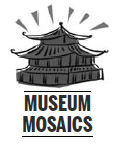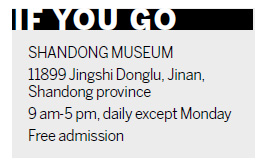Oriental Venus
Updated: 2011-12-12 11:18
By Zhao Ruixue and Ju Chuanjiang (China Daily)
|
|||||||||||
 |
|
The Cicada Crown Bodhisattva of the Northern Wei period is a precious relic of religious art in Shandong. Ju Chuanjiang / for China Daily |
 It is a beautiful sculpture representative of religious art from the Northern Wei. Though it lost its arms to the ravages of time, it is nonetheless outstanding in its serenity and beauty. Zhao Ruixue and Ju Chuanjiang tell the story.
It is a beautiful sculpture representative of religious art from the Northern Wei. Though it lost its arms to the ravages of time, it is nonetheless outstanding in its serenity and beauty. Zhao Ruixue and Ju Chuanjiang tell the story.
The lone Bodhisattva statue stands in the Shandong Museum's exhibition hall of religious figures, serene and benevolent, with nothing to betray a turbulent past. It's often called the Oriental Venus, mainly due to its half-smiling countenance and armless state.
Its discovery began in 1978 when Zhang Lishan, a villager in Zhangguan Village, Bo'xing county in Shandong province, dug up the statue while building a house around the site of Longhua Temple, built during the Northern Wei period (AD 386-534).
To Zhang, it was no big deal. Villagers dug out bits and parts of old statues all the time around the site. Zhang threw the excavated pieces aside at the back of the village, where they were taken away and used as tables and stools.
This finally caught the attention of Li Shaonan, the former head of the Bo'xing Cultural Heritage organization and he began to collect the sculpture fragments. Between 1980 and 1982, Li collected hundreds of broken parts.
The Bodhisattva statue was pieced together from three recovered parts in 1980 and kept in Bo'xing, becoming known as the Cicada Crown Bodhisattva after the insect carved on the front of its head.
Unfortunately, it was reported stolen in 1994 from the collection at Bo'xing and not until five years later did scholars notice the stolen figure listed in the collection of the Miho Museum in Japan.
"Two letters indicated that the stolen statue might be in the Miho Museum. One was from the Maecenas Foundation in Switzerland; the other was actually a confidential letter from the Institute of Archaeology under the Chinese Academy of Social Sciences," Xiao Guitian, an expert on the Buddhist sculptures at Shandong Museum, told China Daily.
After several rounds of negotiations, officials from China and the Miho Museum administrators reached a deal in 2001, agreeing that the statue be returned to China without any payment and that China would loan the statue to the Miho Museum until 2007.
At that time, Chinese officials estimated that the statue was worth 100 million yen, or about $830,000. The deal paved the way for increased cultural exchange between China and Japan.
"Currently, we still continue cultural communication with the Miho Museum and the Bodhisattva statue will be exhibited in Japan every five years," Xiao says.
The Cicada Crown Bodhisattva is carved in limestone, and stands about 120 cm tall.
The statue is set against a circular nimbus with a lotus rosette, and it is draped in pearls and ribbon cords with its skirt falling in delicate folds.
"The Bodhisattva's abstract expression is in line with the orthodox Northern Wei habit," Xiao explains.
But the outstanding characteristic is the cicada on the front of its crown. Identified with Buddhism, the insect is a symbol of integrity and nobility and has been often used by poets to express benevolence.
In the Han Dynasty (206 BC-AD 220), the cicada also appeared on the headgear of high officials.
Shandong boasts a long history, and is famous as the birthplace of Confucius, Mencius and Sun Tzu, the author of Art of War.
Buddhism has set deep roots in Shandong, with many early temples, including the Shentong Temple, built in AD 351 near the capital Ji'nan. It was originally named Langgong Temple (郎公寺), but was later renamed Shentong Temple (神通寺).
Buddhism in China did not go unchallenged. During two anti-Buddhist purges in the Northern Wei period, devout Buddhist followers dug pits to hide their sculptures, thus leaving a future legacy for Shandong.
Since the 1980s, many Buddhist statues have been excavated in different parts of Shandong. Besides Ji'nan, major excavation sites are at Qingzhou, Binzhou, Guangrao, Bo'xing, Anqiu and Zhucheng.
In the Shandong Museum, there is a large collection of Buddhist figures made from bronze, stone and bisque-fired ceramic that offers an overview of Shandong Buddhist figurine art through the centuries from the 16 Kingdoms (304-439), Northern Wei (386-534), Eastern Wei (534-550), and Northern Qi (550-577) to the Sui (581-618) dynasties.
But of them all, the serene Cicada Crown Bodhisattva stands out in its quiet magnificence.
You may contact the writers at sundayed@chinadaily.com.cn.